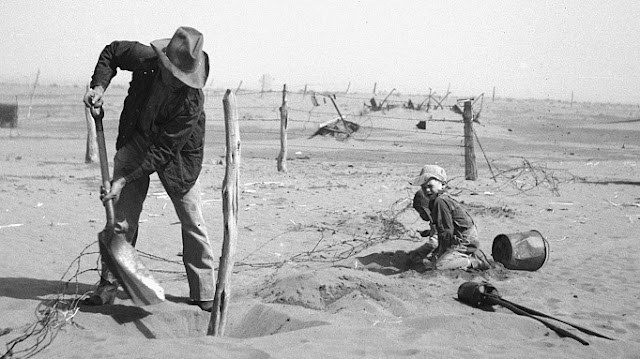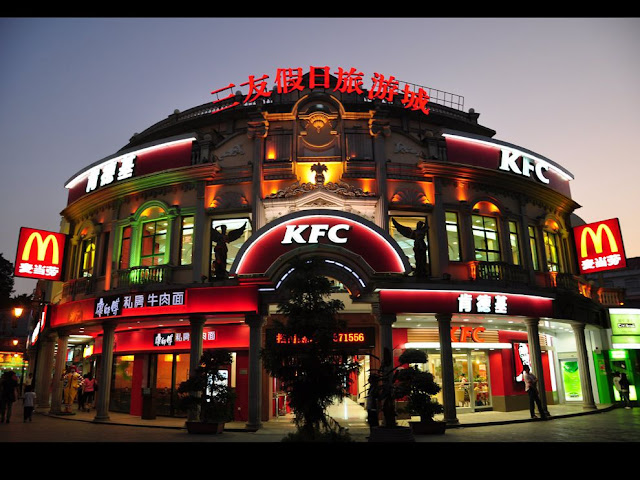Post 4: Live Through This
"In those cedar posts and collapsed homes is the story of this place: how the greatest grassland in the world was turned inside out, how the crust blew away, raged up in the sky and showered down a suffocating blackness off and on for most of a decade. In parts of Nebraska, Kansas, Colorado, New Mexico, Oklahoma and Texas, it seemed on many days as if a curtain were being drawn a vast stage at world's end. The land convulsed in a way that had never been seen before, and it did so at a time when one out of every four adults was out of work." (Egan 2006: 2).
On first thought, it might appear that this section of the course, and the book The Worst Hard Time, continues the first theme of the course -- the impact of the environment on human populations. And certainly, that's one part of it. The Dust Bowl was one of the worst natural disasters in American history. For nearly a decade, the drought-stricken Great Plains experienced dust storm after dust storm as farm fields literally turned to dust. Some people left, like the fictional Joads,* for greener pastures in California. But many people stayed, fighting the Black Blizzards, hoping to save their farms and homes.
For a timeline and some classic Dust Bowl photographs see:
But that's not the whole story. This section of the course is also about how people affect the environment. The Dust Bowl was not simply an act of nature. In fact, few natural disasters are ever completely natural (including, for example, Hurricane Katrina). The way that humans use -- and sometimes misuse -- the environment can impact the the way natural phenomena, like drought and hurricanes, unfold. In addition, human societies and belief systems shape the experiences of natural phenomena. The Pandemic, for example, is ultimately caused by one virus -- SARS-CoV-2 -- but is experienced differently in different parts of the world, depending upon the social, cultural, political and economic condititions the virus finds itself in.
As Egan's quote reminds us, the Dust Bowl occurred at a time of incredible economic upheaval in the United States. It followed on the heels of the stock market crash of 1929, and coincided with the Great Depression. The Dust Bowl and the Great Depression are not synonymous terms, but they certainly affected one another. Natural disasters do not occur in isolation from social, political, and most importantly, economic circumstances. As you read, also think about how economic pressures, and economic problems, affected the land and people of the Southern Plains.
There are lots of reasons why this book is a favorite of mine: for a start, its beautifully written and it focuses on places and people that I know well. Probably the best part, in my opinion at least, is that Egan does a great job of personalizing the Dust Bowl. Pay attention to the people and their struggles. Can you imagine living during such a time?
Some terms, concepts, and places to consider while you're reading The Worst Hard Time:
1) "rain follows the plow"
2) 100th meridian
3) 20 inches of rainfall
4) No Man's Land (Oklahoma Panhandle): Boise City, Oklahoma
5) Texas Panhandle: Dalhart, Texas
6) Baca County, Colorado
7) last chancers, sod busters, nesters
8) dust pneumonia
9) Homestead Act(s)
* The Joads are the fictional family in John Steinbeck's classic, The Grapes of Wrath. Although I love the book, I feel compelled to point out that any Okie reading it will pick out the geographical flaws early on. Despite Steinbeck's dusty prose, the Joads were from eastern Oklahoma, which suffered years of drought but without the dramatic fields of dust. Steinbeck was right, though, that most migrants to California -- called "Okies"** no matter where they came from -- hailed from the eastern half of the state, which was hard-hit by mortgage foreclosures.
** Today, Oklahomans have reclaimed the term Okie. But during the 1930s, it was a very derogatory term used to describe the poor migrants from Kansas, Oklahoma, Arkansas and Texas. Many of those migrants lived for years in migrant-worker camps and only partially assimilated to California life. To this day, "Okie" is still used to refer to some groups of lower-class white folks living in California.


Comments
Post a Comment